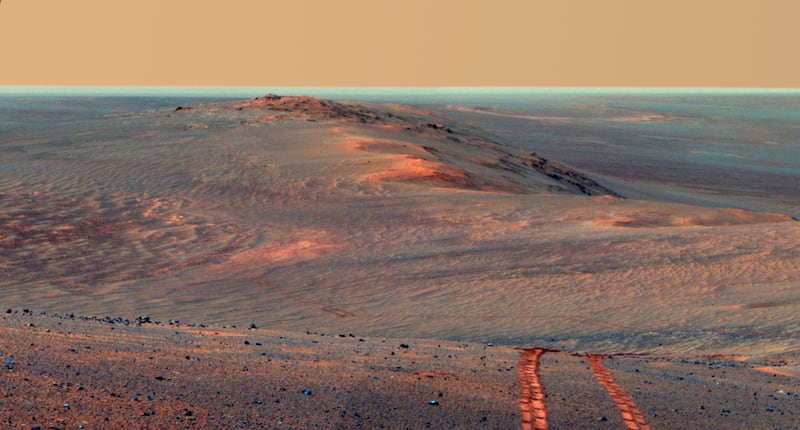A Mars rover that was designed to carry out research for 90 days but went on to operate for almost 15 years has officially been declared dead by US space agency Nasa.
Engineers last received communication from the history-setting Opportunity rover on June 10 last year, before it was caught up in a severe dust storm on the Red Planet.
A final attempt to make contact with Opportunity was made on Tuesday to no avail, Nasa said, following more than 1,000 commands to restore communications.
“We have made every reasonable engineering effort to try to recover Opportunity and have determined that the likelihood of receiving a signal is far too low to continue recovery efforts,” said John Callas, manager of the Mars Exploration Rover project at Nasa’s Jet Propulsion Laboratory.
Opportunity – affectionately known as Oppy – arrived on Mars on January 24 2004, seven months after it was launched from Cape Canaveral Air Force Station in Florida, on a mission to uncover evidence of life.
The solar-powered rover was only expected to travel 1,000 metres on Mars, but amassed 28 miles and set a one-day driving record on March 20 2005, when it managed 220 meters.
Today, we're saying #ThanksOppy as the @MarsRovers mission comes to an end. 6 things to know about our record-breaking, discovery-making, marathon-driving rover, which found that ancient Mars was awash in water… and some of the best images it sent back: https://t.co/ZR7pxBP1ZF pic.twitter.com/2L0gzr4WNJ
— NASA (@NASA) February 13, 2019
During its time on the Martian surface, Opportunity sent more than 217,000 images back to Earth, and uncovered the surfaces of 52 rocks with fresh mineral surfaces for analysis.
It also found a mineral known as hematite that forms in water, as well as other indications that could help answer the question of life on Mars.
“From the get-go, Opportunity delivered on our search for evidence regarding water,” said Steve Squyres, principal investigator of the rovers’s science payload.
“And when you combine the discoveries of Opportunity and Spirit, they showed us that ancient Mars was a very different place from Mars today, which is a cold, dry, desolate world. But if you look to its ancient past, you find compelling evidence for liquid water below the surface and liquid water at the surface.”

The six-wheeled vehicle outlived its twin rover Spirit, which managed almost five miles on the planet before ceasing in May 2011.
Attempts to explore the Red Planet continue with newer missions, including Nasa’s InSight lander which touched down on November 26.
The European Space Agency’s ExoMars rover, recently named after British scientist Rosalind Franklin, is expected to launch in July 2020 on its own mission to find signs that life could have once existed on Mars.
“It is because of trailblazing missions such as Opportunity that there will come a day when our brave astronauts walk on the surface of Mars,” said Jim Bridenstine, Nasa administrator.
“And when that day arrives, some portion of that first footprint will be owned by the men and women of Opportunity, and a little rover that defied the odds and did so much in the name of exploration.”








